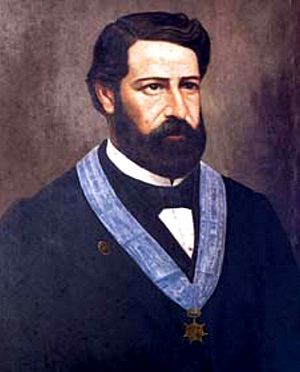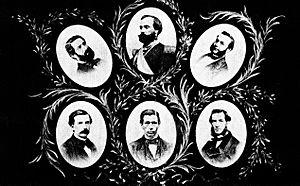José Gálvez Egúsquiza facts for kids
Quick facts for kids
José Gálvez Egúsquiza
|
|
|---|---|
 |
|
| Minister of War and Navy | |
| In office November 26, 1865 – May 2, 1866 |
|
| President | Mariano Ignacio Prado |
| Preceded by | José Balta |
| Succeeded by | Pedro Bustamante |
| President of the National Convention (Congress of Peru) |
|
| In office 1856–1856 |
|
| Preceded by | Miguel de San Román |
| Succeeded by | Manuel Toribio Ureta |
| In office 1857–1857 |
|
| Preceded by | Francisco Quirós |
| Succeeded by | Convention closed |
| Constituent Deputy for Pasco (Junín) | |
| In office July 14, 1855 – November 2, 1857 |
|
| Personal details | |
| Born | March 17, 1819 Cajamarca |
| Died | May 2, 1866 (aged 47) Callao |
| Parents | José Gálvez Paz María Micaela de Egúsquiza |
| Alma mater | National University of San Marcos |
| Military service | |
| Allegiance | |
| Branch/service | |
| Years of service | 1854–1855, 1860, 1866 |
| Rank | Colonel |
| Battles/wars | Liberal Revolution of 1854 1860 Coup d'état attempt Peruvian Civil War of 1865 Chincha Islands War |
José Gabriel Gálvez Egúsquiza (born in Cajamarca, Peru, on March 17, 1819 – died in Callao, Peru, on May 2, 1866) was an important Peruvian figure. He was a lawyer, a professor, and a liberal politician. During the presidency of Mariano Ignacio Prado, he served as the Minister of War and Navy in 1865. He bravely died fighting the Spanish fleet during the Battle of Callao. Because of his sacrifice, he became a symbol of independence for all of America.
A Chilean historian, Benjamín Vicuña Mackenna, met him. He described Gálvez as a modest man. He was small, dark, and pale. He always looked neat and had very kind manners. But beneath this calm appearance, he had a big heart and a brilliant mind.
Contents
Biography: José Gálvez's Early Life and Education
José Gálvez Egúsquiza was born to Colonel José Manuel Gálvez Paz and María Micaela Egúsquiza y Aristizábal. He was the oldest of his siblings. His brothers included Pedro Gálvez Egúsquiza and Manuel María Gálvez Egúsquiza. José began his studies at the Cajamarca Central College of Sciences and Arts. This school was run by a priest named Juan Pío Burga. After finishing school, he helped his parents on their farm, the Catudén Hacienda.
In 1842, José moved to Lima. He enrolled at the San Carlos convictorio, which was a type of boarding school and university. The head of the school was clergyman Bartolomé Herrera. José earned his bachelor's degree in 1843. He then became a lawyer in 1845. For five years, he worked as a lawyer in the Cerro de Pasco and Tarma areas. These regions are in the central mountains of Peru.
Teaching and Political Beginnings
José returned to Lima in 1850. He became a professor at the Nuestra Señora de Guadalupe National College. He taught subjects like Moral Philosophy, Psychology, and Logic. In 1852, he became the director of the college. He took over from his brother, Pedro Gálvez. José brought a strong liberal approach to the studies. This was different from the more traditional teaching at the San Carlos convictorio.
He left teaching to join the Liberal Revolution of 1854. This revolution was led by General Ramón Castilla in Arequipa. José helped to end the tax on indigenous people and free slaves in 1854. He had always supported these ideas in his teaching. After the successful battle of La Palma in January 1855, he became the head of the Convictorio de San Carlos. There, he worked to reduce the influence of conservative ideas.
Role in the National Convention
Later, José was elected as a representative for the province of Pasco. He became a member of the National Convention of 1855. This group was formed to create a new Constitution for Peru. It would replace the 1839 Constitution. When the Convention started on July 13, 1855, Gálvez was chosen as Secretary. He was re-elected several times for this role. On February 1, 1856, he was elected President of the Convention. He held this position multiple times. After many discussions, the Convention created the Liberal Constitution of 1856. Gálvez also helped write the Penal Code in 1857.
Exile and Return
In 1857, President Castilla closed the National Convention. This made Gálvez a strong opponent of Castilla. He wrote for the newspaper El Constitucional from April to August 1858. Castilla then called for a new Congress to discuss another Constitution. This was the moderate Constitution of 1860. To stop this new law, Gálvez joined a group with Ricardo Palma and other liberals. They planned to attack Castilla's house on November 23, 1860. The plan failed, and Gálvez had to seek safety in the Chilean embassy in Lima. He then went into exile in Europe.
On December 14, 1860, he left Callao with one of his children. He traveled to Panama, then to Paris, and finally to Geneva. He returned to Peru on November 2, 1862, and focused on his law career. The next year, he earned a doctorate in Law from the National University of San Marcos. His thesis argued that scientific institutions should be independent from the government.
Minister of War and Heroic Death
In 1865, José Gálvez was elected head of the Lima Bar Association. In his opening speech, he criticized President Juan Antonio Pezet. Pezet seemed too passive against the attacks from the Spanish Pacific Squad. Because of this, Gálvez was exiled to Chile again. He soon returned to Peru and joined the revolution in Chincha. This revolution was led by Colonel Mariano Ignacio Prado. Gálvez asked to fight, and his request was accepted. He was given the rank of colonel. After the revolution won, Prado became the leader. Gálvez was appointed Minister of War and Navy. He was part of the famous Cabinet of Talents in 1865, and he was its leader.
In April 1866, Admiral Casto Méndez Núñez, commander of the Spanish fleet, threatened to bomb Callao. He made this threat from the frigate Numancia. Gálvez took charge of defending the port of Callao. He quickly built many batteries, or gun placements, in the north and south. He placed the few warships in the center. The northern defenses included the Junín tower and the Ayacucho fort. In the south were the Santa Rosa fort, the Merced tower, and the Zepita battery.
On May 2, 1866, the fighting began. Early on, one of the cannons at Fort Santa Rosa was damaged. A bomb from the Spanish frigate Almansa hit the Merced tower. It landed in a gunpowder storage area, causing a huge explosion. The tower was destroyed, and José Gálvez died there. Many officers and soldiers also died with him.
The next day, the Peruvian Government honored Gálvez. They ordered that he be considered the "First Chief" of the Plaza Artillery Battalion. When his name was called during a review, the commander replied: "He died heroically in the Defense of the Homeland and in Honor of America." Gálvez was buried in a special tomb at the Presbítero Maestro Cemetery.
Legacy: A Peruvian Hero
In Peru, José Gálvez is seen as a war hero. His status is similar to that of Miguel Grau and Francisco Bolognesi. Both of them died in the later War of the Pacific. Gálvez also had a big influence against old-fashioned ideas. He promoted liberal democracy in education. People who supported these ideas after his death remembered his work.
A victory column was built in Lima, near the old city wall. It was meant to have a bust of Gálvez at the top. But later, they decided to put a statue of Victory instead. This was because the monument was meant to honor all the defenders of Callao, not just one person.
Family Life
On September 7, 1846, José Gálvez married Ángela Moreno y Maíz in Tarma. Ángela was the daughter of José Moreno y Mantilla and María del Carmen Maíz. Her family was wealthy and involved in mining. José and Ángela had seven children:
- María Gálvez Moreno, who married Samuel Palacios Mendiburu in 1882.
- Angélica Gálvez Moreno, who married Manuel Bernardo Sayán Palacios in 1892.
- Justiniano Aurelio Gálvez Moreno, who married Amalia Barrenechea de la Fuente. Amalia was the daughter of the lawyer and diplomat José Antonio Barrenechea y Morales. Their son was the politician José Gálvez Barrenechea.
- José Gálvez Moreno, a politician, sailor, and Peruvian war hero. He married Enriqueta Evens y Evens.
- Luis Augusto Gálvez Moreno
- Gerardo Wencelao Gálvez Moreno
- Carlos Enrique Gabriel Gálvez Moreno
See also
 In Spanish: José Gálvez Egúsquiza para niños
In Spanish: José Gálvez Egúsquiza para niños
- Pedro Gálvez Egúsquiza
- Manuel María Gálvez Egúsquiza


